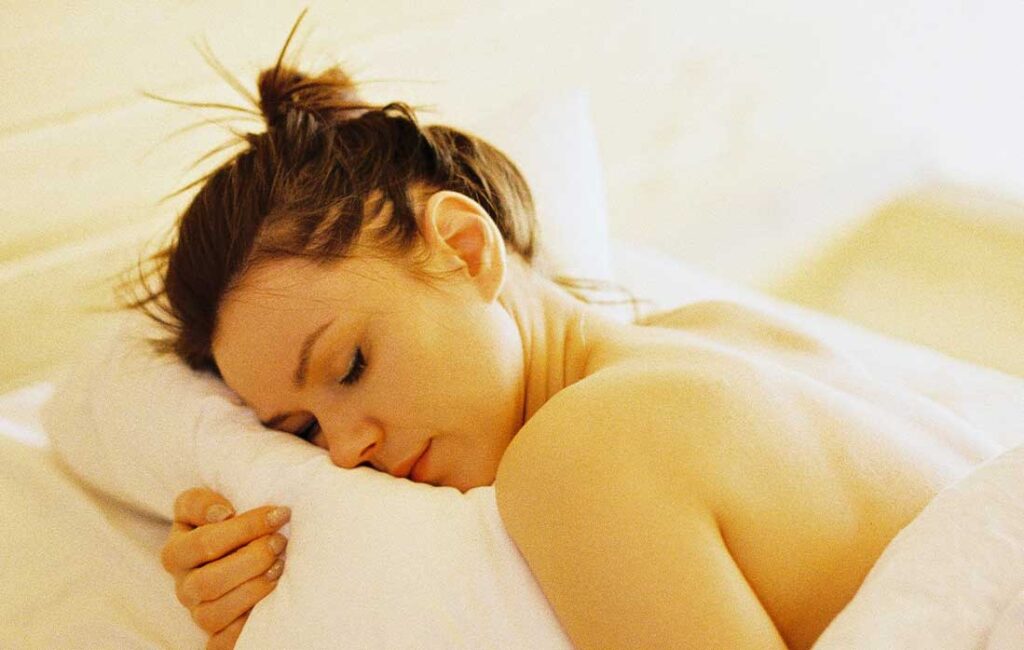
When temps skyrocket during a heat wave, sleep can be hard to come by. Most people instinctively shed as much clothing and blankets as possible, welcoming any airflow on the skin in hopes of keeping even a tiny bit cooler. Though sleeping in the buff seems like a no-brainer, like many things nowadays, the practice has been met with online controversy. Some experts claim that sleeping naked is the last thing you should do during a heat wave. So, who is right?
Bedroom Temperature and Sleep
Your bedroom temperature affects your body temperature, especially concerning circadian rhythms that dictate sleep patterns. As your body winds down for sleep, it starts to cool itself, lowering your internal temperature and working with melatonin to ease you into unconsciousness.
The recommended room temp range for sleeping is between 65 and 70°F, and anything above that can negatively impact sleep. In fact, research published in the journal Sleep found that every increase in room temperature of 1°F between 60-85°F led to a 0.06% decrease in sleep efficiency.
During heat waves, the outdoor temperatures can climb to over 90°F, and sometimes, homes can approach and exceed this temperature, making them unsafe to stay in, according to the CDC, even with a fan. But so long as your home is cooler than this, using a fan can help your skin evaporate sweat—especially if your skin is exposed (read: naked)
Sleeping Naked in a Heat Wave
Lauri Leadley, certified in clinical sleep health, a Registered Polysomnographic Technologist, and President and Clinical Sleep Educator Founder of Valley Sleep Center, believes that sleeping naked is the best choice for your health, including during a heat wave. “The simple fact is that you will be cooler while sleeping without any extra clothing,” she says
“When our bodies can’t reach the optimal core temperature for sleep, it causes insomnia and disrupts sleep. Wearing pajamas can keep the body from reaching this optimal temperature and may even lead to overheating at night,” explains Leadley.
One study published in the Journal of Physiological Anthropology found when bedding and clothing are used, heat exposure increases wakefulness and decreases slow wave and rapid eye movement sleep stages. If the heat is coupled with humidity, as is often the case in the worst heat waves, it has an even more significant negative impact on sleep stages and thermoregulation.
Beyond insomnia and sleep disruption, Leadley says sleeping in hot temperatures in PJs can create a breeding ground for yeast and bacteria. “Sleeping naked allows for better ventilation than sleeping in panties and/or PJs; this helps create a less hospitable area for fungal and bacterial infections to develop,” she explains.
How to Sleep Better During a Heat Wave
Dr. Robert Philip Lindeman, MD, Ph.D., Doctor and Contributor at My Pulmonary Hypertension Team, disagrees with others that sleeping naked during a heat wave is risky but says there are no particular health benefits one way or another. “Circulating air with a fan can help, as can opening the window, provided you can do so safely and without introducing too much outside noise,” he says.
Some other smart moves for a more comfortable sleep during the dog days of summer: keep your windows covered during the day and open them at night if you don’t have AC, sleep on the lowest level of your house or the floor if you can (hot air rises), invest in an AC unit if possible, and consider purchasing bedding that helps keep you cool and dry such as mattress toppers and sheets.
“For those who cannot control the climate in our sleeping space, such as with an air conditioner, the key is to make yourself as comfortable as possible. If you cannot sleep comfortably naked in normal weather, then choosing to do so during a heat wave is probably a bad idea,” explains Lindeman. If this is you, choosing some sweat-wicking PJs might do the trick.
Lindeman sums it up: “The bottom line is to dress for bed in the most comfortable way to you and forget about unlikely health effects.”
Sources
Harding EC, Franks NP, Wisden W. Sleep and thermoregulation. Curr Opin Physiol. 2020 Jun;15:7-13. doi: 10.1016/j.cophys.2019.11.008. PMID: 32617439; PMCID: PMC7323637.
A Raj and others, 1214 Higher Bedroom Temperature Associated With Poorer Sleep: Data From Over 3.75 Million Nights, Sleep, Volume 43, Issue Supplement_1, April 2020, Page A464, https://doi.org/10.1093/sleep/zsaa056.1208
Leadley, Lauri. Author interview. June 2024.
Lindeman, Robert Philip. Author interview. June 2024.
Okamoto-Mizuno, K., Mizuno, K. Effects of thermal environment on sleep and circadian rhythm. J Physiol Anthropol 31, 14 (2012). https://doi.org/10.1186/1880-6805-31-14




























